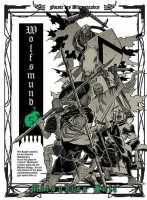My News and Reviews
Last week at Experiments in Manga I posted a review of Kaori Ekuni’s quiet yet devastating novel God’s Boat. Ekuni’s debut novel Twinkle Twinkle is one of my favorites, so I made it a point to read more of her work. The underlying premise of God’s Boat—a young woman and her daughter living their lives together while the child’s father has gone missing—is somewhat similar to Hiromi Kawakami’s novel Manazuru which a I read relatively recently, but the two books are very different. I find Ekuni’s work to be very effective, so I wish that more was available in translation. Last week I also posted my second Adapatation Adventures feature, this time taking a closer look at The Twelve Kingdoms and comparing the anime adaptation with the original novels. Both version of The Twelve Kingdoms are excellent. I’m really hoping that one day the novels might be licensed again.
As for other interesting reading that I discovered last week, Brigid Alverson wrote A Brief History of Ultraman in honor of Viz licensing one of the more recent Ultraman manga. Jonathan Clements posted an article about the Japanese manga industry, particularly in regards to digital publishing. Alicia at Things We Lost at Dusk translated an excerpt of an interview with Hanamura Eiko, Chiba Tetsuya, and Takemiya Keiko about drawing girls in early shoujo manga. Other interesting things of note, the 2015 Eisner Award Nominations have been announced. As always, there are some great comics on the list. Though, as usual, manga has for the most part been relegated into the Best U.S. Edition of International Material—Asia category: All You Need Is Kill, In Clothes Called Fat, Master Keaton, One-Punch Man, Showa: A History of Japan, and Wolf Children: Ame & Yuki. The major exception this year is Massive: Gay Erotic Manga and the Men Who Make It which is up for Best Anthology. Viz’s Hello Kitty, Hello 40: A Celebration in 40 Stories was also nominated in the Best Publication for Early Readers category. And speaking of Viz, the publisher is currently running a survey about social media and websites.
Quick Takes
 Let’s Dance a Waltz, Volume 1 by Natsumi Ando. I’ve previously read two other series in which Ando was involved: Kitchen Princess and Arisa. Her manga tend to incorporate a fair number of well-worn shoujo tropes and melodrama, which is true of Let’s Dance a Waltz as well. But, the manga are put together in such a way that makes for an enjoyable read even if the series aren’t particularly ground breaking. Let’s Dance a Waltz is cute, and I liked the series’ focus on ballroom dancing, which isn’t often seen in manga in English. However, one thing that really annoyed and bothered me was how Ando handled Himé’s weight at the end of the volume. After two weeks of intense dancing, she loses over forty pounds, becoming stereotypically slim and pretty. She was already cute before that though. Sadly, I suppose it was too much to ask that her and the series’ expressed admiration of the other dancers was an appreciation of their elegance and confidence rather than their slim figures. But at least Himé seems to be interested in dancing for dancing’s sake rather than as a weight loss program.
Let’s Dance a Waltz, Volume 1 by Natsumi Ando. I’ve previously read two other series in which Ando was involved: Kitchen Princess and Arisa. Her manga tend to incorporate a fair number of well-worn shoujo tropes and melodrama, which is true of Let’s Dance a Waltz as well. But, the manga are put together in such a way that makes for an enjoyable read even if the series aren’t particularly ground breaking. Let’s Dance a Waltz is cute, and I liked the series’ focus on ballroom dancing, which isn’t often seen in manga in English. However, one thing that really annoyed and bothered me was how Ando handled Himé’s weight at the end of the volume. After two weeks of intense dancing, she loses over forty pounds, becoming stereotypically slim and pretty. She was already cute before that though. Sadly, I suppose it was too much to ask that her and the series’ expressed admiration of the other dancers was an appreciation of their elegance and confidence rather than their slim figures. But at least Himé seems to be interested in dancing for dancing’s sake rather than as a weight loss program.
 Lies & Kisses Masara Minase. A few of Minase’s boys’ love manga have been translated into English, but so far Lise & Kisses is the only one that I’ve actually read. Tatsuya has been searching for his long-lost half-brother Haruka and unwittingly sleeps with him after bringing an attractive stranger home from the bar one evening. Haru does switch from being the adoring younger brother to the sex-craving lover surprisingly easily and quickly, so the manga loses its believability very early on. But ignoring that, the aptly named Lies & Kisses actually handles the characters’ emotional turmoil and baggage surprisingly well. The reasons for Haru and Tatsuya’s repeated miscommunication makes sense and their conflicting feelings as their relationship evolves are understandable. When it is revealed that they may or may not actually be related by blood, even more emotional drama ensues. Most of the decisions made by the two men to lie and to hide things from each other, while misguided, are generally done so with good intentions and with concern for the other’s well-being.
Lies & Kisses Masara Minase. A few of Minase’s boys’ love manga have been translated into English, but so far Lise & Kisses is the only one that I’ve actually read. Tatsuya has been searching for his long-lost half-brother Haruka and unwittingly sleeps with him after bringing an attractive stranger home from the bar one evening. Haru does switch from being the adoring younger brother to the sex-craving lover surprisingly easily and quickly, so the manga loses its believability very early on. But ignoring that, the aptly named Lies & Kisses actually handles the characters’ emotional turmoil and baggage surprisingly well. The reasons for Haru and Tatsuya’s repeated miscommunication makes sense and their conflicting feelings as their relationship evolves are understandable. When it is revealed that they may or may not actually be related by blood, even more emotional drama ensues. Most of the decisions made by the two men to lie and to hide things from each other, while misguided, are generally done so with good intentions and with concern for the other’s well-being.
 UQ Holder!, Volume 4 by Ken Akamatsu. I continue to be somewhat frustrated by UQ Holder! and the hero’s ambiguous and seemingly directionless ambitions, but I have liked the last couple of volumes more than the first two. Tōta’s goal is still extraordinarily vague and uncomplicated—as far as I can tell, at this point it basically amounts to just wanting to be awesome—but at least the fight scenes tend to be fairly entertaining. The part of UQ Holder! that currently interests me the most is the wide variety of immortals in the series. This particular volume reveals yet another character with a special skill that, with careful use, more or less renders her immortal. Functionally, she is able to create a “save point” which, although it does have its limitations, is an admittedly cool ability. The fourth volume also ties UQ Holder! in a little closer to the tangentially related series Negima! by introducing one of its major characters, Fate Averruncus, as a primary antagonist. Hopefully this means the story of UQ Holder! will become more engaging now that it seems that the manga might be developing an actual plot.
UQ Holder!, Volume 4 by Ken Akamatsu. I continue to be somewhat frustrated by UQ Holder! and the hero’s ambiguous and seemingly directionless ambitions, but I have liked the last couple of volumes more than the first two. Tōta’s goal is still extraordinarily vague and uncomplicated—as far as I can tell, at this point it basically amounts to just wanting to be awesome—but at least the fight scenes tend to be fairly entertaining. The part of UQ Holder! that currently interests me the most is the wide variety of immortals in the series. This particular volume reveals yet another character with a special skill that, with careful use, more or less renders her immortal. Functionally, she is able to create a “save point” which, although it does have its limitations, is an admittedly cool ability. The fourth volume also ties UQ Holder! in a little closer to the tangentially related series Negima! by introducing one of its major characters, Fate Averruncus, as a primary antagonist. Hopefully this means the story of UQ Holder! will become more engaging now that it seems that the manga might be developing an actual plot.
 Wolfsmund, Volumes 5-6 by Mitsuhisa Kuji. If I recall correctly, Wolfsmund was initially expected to end with the sixth volume, but it looks like there will be at least seven volumes if not more. Wolfsmund is an extraordinarily brutal manga and its violence is not at all romanticized. The fighting and torture is savage and cruel, making the series an uncomfortable read at times. In these two volumes of Wolfsmund, the Swiss rebellion continues its attack on the “Wolf’s Maw” of Sankt Gotthard Pass. Austrian reinforcements are expected, so their time is limited. They must overtake the barrier station and its bailiff as quickly as possible. Desperate measures are needed in order to accomplish that. The rebels literally throw their lives and bodies at the fortress, becoming willing participants in what amounts to a suicide mission. Even after breaching the outer defenses, they still have to contend with the traps found inside the barrier station itself and the clever design of a fortress built to withstand invasion from the outside. The deaths are gruesome and extremely unpleasant, but ultimately the rebels are able to overcome simply because they have a great number of people who are willing to die for their cause.
Wolfsmund, Volumes 5-6 by Mitsuhisa Kuji. If I recall correctly, Wolfsmund was initially expected to end with the sixth volume, but it looks like there will be at least seven volumes if not more. Wolfsmund is an extraordinarily brutal manga and its violence is not at all romanticized. The fighting and torture is savage and cruel, making the series an uncomfortable read at times. In these two volumes of Wolfsmund, the Swiss rebellion continues its attack on the “Wolf’s Maw” of Sankt Gotthard Pass. Austrian reinforcements are expected, so their time is limited. They must overtake the barrier station and its bailiff as quickly as possible. Desperate measures are needed in order to accomplish that. The rebels literally throw their lives and bodies at the fortress, becoming willing participants in what amounts to a suicide mission. Even after breaching the outer defenses, they still have to contend with the traps found inside the barrier station itself and the clever design of a fortress built to withstand invasion from the outside. The deaths are gruesome and extremely unpleasant, but ultimately the rebels are able to overcome simply because they have a great number of people who are willing to die for their cause.

You were critical of UQ Holder, yet somehow you made me want to read it lol. Do you have to read Negima to enjoy/understand UQ Holder?
Haha! Go for it, and let me know what you think! :) I don’t believe reading Negima! is a requirement. At least I’ve been able to follow UQ Holder! without knowing much at all about the previous series. Though, maybe not catching the significance of some of the references is part of why I find the manga frustrating at times? Still, it does have some fun quirks.
Thank you very much for introducing me to “Wolfsmund”, since I live in Switzerland it’s a defenitely a must have for me! :)
You are very welcome! I hope that you enjoy. Wolfsmund is an intense series and definitely not for everyone, but I’m glad that it’s available. :)